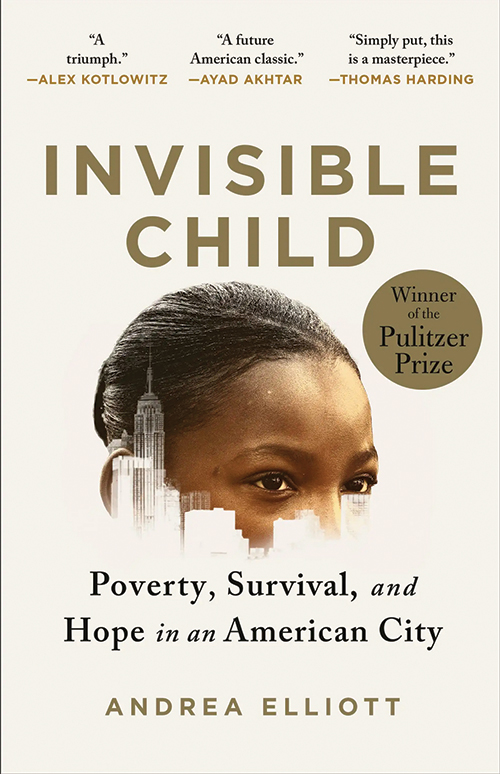
Invisible Child: Poverty, Survival, and Hope in an American City
Reviewed by David Etheridge
October 1, 2022
By Andrea Elliott. Random House, 2021. 624 pages. $32/hardcover; $20/paperback; $12.99/eBook.
In Invisible Child: Poverty, Survival, and Hope in an American City, New York Times reporter Andrea Elliott combines journalism, empathy, and detailed research to describe for us the struggles of a New York City family of ten navigating homelessness, poverty, and racism.
She tells each person’s story from that person’s own perspective. She takes that approach not only for the family members who are the center of the story but also for the social workers, teachers, politicians, philanthropists, and others who have an impact on them. She tells their story in detail and provides important historical and political context. The author clearly has her own perspective, but she leaves judgments and recommended solutions to the readers.
The book began as a series of articles in the New York Times in December 2013 focusing on an 11-year-old girl named Dasani living with her parents and seven siblings in a single room of a homeless shelter in Brooklyn. The author chose Dasani because she “could narrate her own experience of growing up poor,” not because she was “‘representative’” of any “demographic trends.”
When Dasani’s great-grandfather was discharged from the military at the end of the Second World War, he moved from North Carolina to the Bedford-Stuyvesant neighborhood of Brooklyn. He was eligible for housing benefits as a veteran, but he could not use them because banks would not lend money for a home in a Black neighborhood, and realtors would not sell a home to him in a White one.
After Dasani’s grandfather died in a construction accident, her grandmother worked for eight years cleaning subway trains while Dasani and the rest of her immediate family lived in homeless shelters. When the grandmother died in 2008, she had saved enough money for Dasani’s family to combine the small inheritance with a new government subsidy for homeless families to enable them to rent a home in Staten Island. By 2011, both the inheritance and the subsidy had been exhausted, and the family moved into another shelter. That is the point at which they met the author.
Both of Dasani’s parents “are unemployed, have a history of arrests, and are battling drug addiction.” They were also subject to a set of policies and programs designed to “push the homeless to become more self-reliant.” To participate in those programs, family members must surrender their freedom and be subjected to monitoring, judgment, and sometimes punitive measures that government officials believe will make them more self-reliant. For example, failing to return to the shelter by curfew required the family to travel to a distant office the following day to be “logged back in.” Evidence of illegal drugs could and did cause parents to be evicted or forbidden to live with their children.
Dasani was responsible for much of the care of her younger siblings, which required her to wake up hours before she needed to be at school. That work instilled in her a strong sense of responsibility as well as strong bonds with those siblings. It also caused her to be labeled by teachers and social workers as a “‘parentified child,’” which is considered a toxic condition.
In fall 2014, the family obtained a housing subsidy voucher, which enabled them to move again to Staten Island. One of Dasani’s teachers recommended her for admission to the Milton Hershey School for “children in need” in Hershey, Pa. She was admitted in January 2015. While she did well in the very supportive environment of the school, others in her family had difficulties that caused her siblings to be dispersed to foster homes. Dasani blamed her absence for those difficulties. She got involved in fights at Hershey that caused her to be expelled.
She returned to New York where she too was placed in foster care. She continued to get into fights, but she was also a good student. In 2019, she became the first in her family to graduate from high school. She and other family members also became involved in courtroom fights that partially reunited the family in another homeless shelter. They were aided by a particularly tenacious attorney who returned from semi-retirement to take their case because he had read the 2013 New York Times series and admired Dasani and her mother.
Invisible Child is based on immersive journalism where the journalist shows up so frequently and persistently that she is inevitably an occasional part of the story. The result is a rich and nuanced account that overcomes the stereotypes that often constitute most of what people think they know about the lives of the urban poor.
David Etheridge is a member of Friends Meeting of Washington (D.C.) and clerk of the Baltimore Yearly Meeting Working Group on Racism.
2 thoughts on “Invisible Child: Poverty, Survival, and Hope in an American City”
Leave a Reply
Comments on Friendsjournal.org may be used in the Forum of the print magazine and may be edited for length and clarity.



This is a splendid review, perhaps telling too much of the story, but it refers to many lessons for communities in general, and for schools, teachers, and government services for families in severe difficulty. This history of the black struggle is a vivid example & demands respect.
I work with the same kind of population in Costa Rica..but here they are refugees and immigrants fleeing from repressive governments. I have written as yet unpublished books called “Out of the Labyrinth” about street kids, “All She Could See was Hearts”, ” The Invislble Children” living under bridges…We need to be able to get the word out to “helpers” about the truth of the lives of people…thank you for your work.